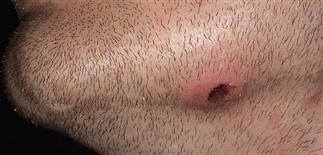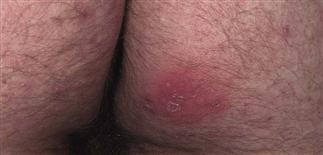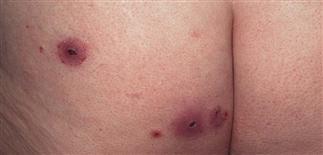50
Furuncles and carbuncles

Furuncle: a bright-red nodule with several pustules on the surface and a rim of erythema.

Furuncle on the chin. An erythematous tender nodule that drained in the center, releasing purulent exudate.

Tender inflammatory plaque that is fluctuant on palpation and has several pustules on the surface where the lesion is draining.

Furuncles may be multiple, as in this case. The tender inflammatory nodules have spontaneously drained. Culture is positive for Staphylococcus aureus. Antibiotic sensitivity patterns are changing; check when prescribing therapy.
DESCRIPTION
• Furuncle. Walled-off, deep, painful, firm, or fluctuant mass enclosing a collection of pus; often evolves from superficial folliculitis. Staphylococcus aureus is most commonly associated organism, but other organisms (Escherichia coli, Pseudomonas aeruginosa, Streptococcus faecalis) and anaerobes cause lesions. Methicillin resistant Staph. aureus has become an increasing problem. • Carbuncle. Extremely painful, deep, interconnected aggregate of infected, abscessed follicles.
HISTORY
• Uncommon in children. • Occlusion and hyperhidrosis, diabetes, immune defects are risk factors. • High friction and sweating sites most often affected, such as beltline, anterior thighs, buttocks, groin, axillae, waist.
PHYSICAL FINDINGS
• Furuncle. Deep dermal or subcutaneous, red, swollen, and painful mass later points toward skin surface and drains through multiple openings. • Carbuncle. Deep, tender, firm, subcutaneous, erythematous papules enlarge to deep-seated nodules; stable or become fluctuant within days. Fever may be associated.
TREATMENT
• Warm dressings 15–30 min. • Incision, drainage is primary management for fluctuant lesions. Local anesthesia required. Iodoform gauze used for packing drained lesions; remove daily followed by wound cleansing. Follow up to ensure treatment response. • Culture and sensitivity for large, advancing, or atypical complicated lesions. Oral therapy appropriate for complicated cases but lesion must be cultured, with antibiotic choice based on sensitivity results. • For susceptible S. aureus some options include: Dicloxacillin 250–500 mg q.i.d. for 10 days (adults). Cephalexin 250–500 mg q.i.d. for 10 days (adults); 40–50 mg/kg t.i.d. (children). Amoxicillin and clavulanate 875 mg b.i.d. for 10 days (adults); children aged more than 3 months and weighing less than 40 kg can be given 45 mg/kg b.i.d. or t.i.d. Clindamycin 150–300 mg q.i.d. for 10 days (adults); 15 mg/kg q.i.d. for 10 days (children). Nafcillin or oxacillin 2 g i.v. every 6 h for moderate to severe infections. Incidence of methicillin-resistant S. aureus is increasing; culture and sensitivity increasingly important. Trimethoprim–sulfa or doxycycline are often first-line options in cases of methicillin-resistant S. aureus when oral therapy is appropriate.
Recurrence
• Eradicate S. aureus carriage. Mupirocin cream (Bactroban) or ointment applied to wounds and nares b.i.d. for 5 days or rifampin 600 mg for 10 days and either dicloxacillin 500 mg q.i.d. or trimethoprim–sulfamethoxazole one double-strength tablet b.i.d. for 10 days. • Methicillin resistance. Mupirocin 2% in nares and wounds twice daily for 1–2 weeks, or one trimethoprim–sulfamethoxazole double-strength tablet b.i.d. orally for 10 days, and rifampin 600 mg q.d. for 10 days. Betadine or chlorhexidine wash of body, fingernails daily for 1–3 weeks and changing, washing towels, bed sheets daily. Change wound dressings frequently; clean or replace shaving tools daily; avoid nose picking.







